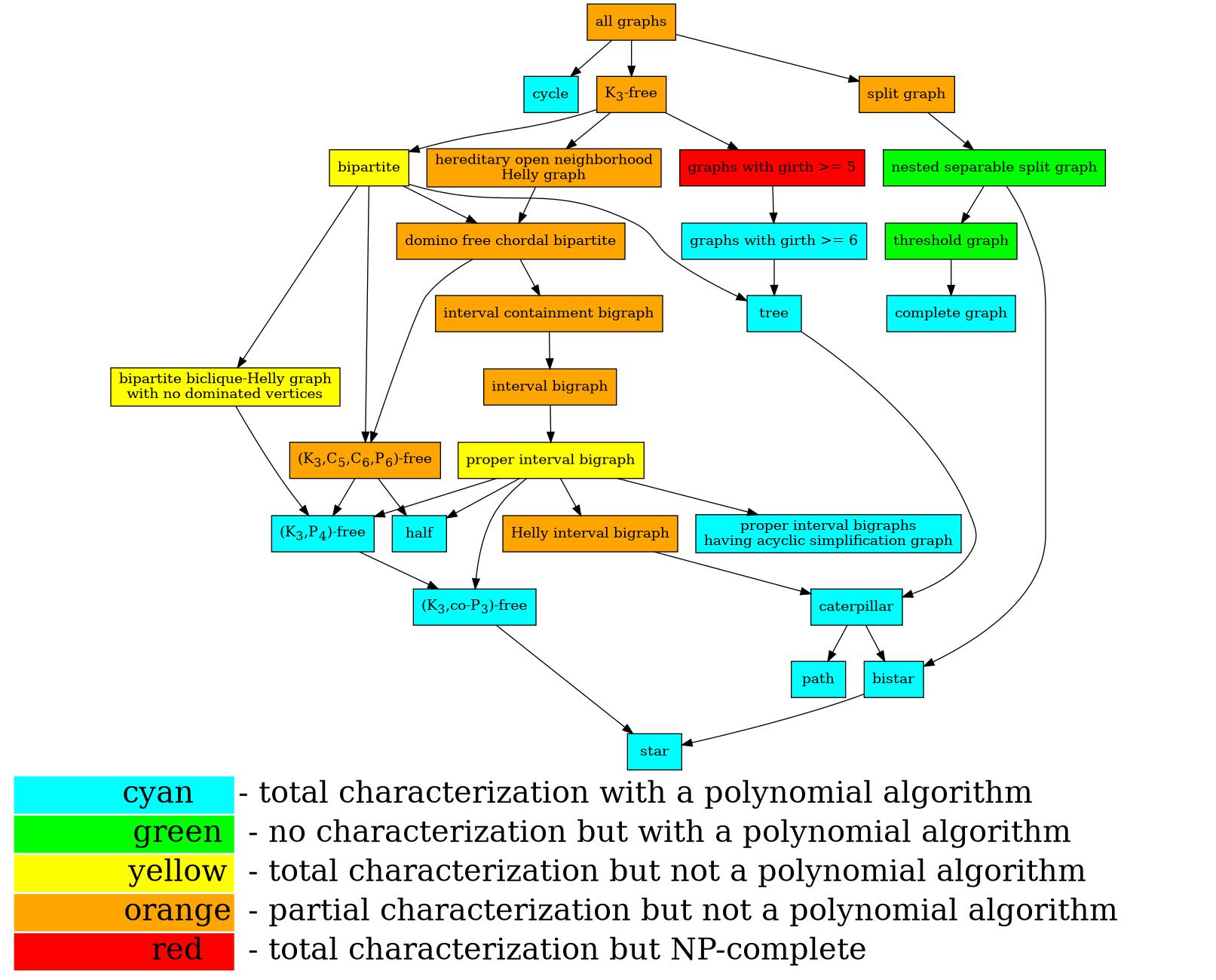Recognition of Biclique Graphs of Some Graph Classes
There is a PDF version (with references) that can be accessed here.
| class \(\mathcal{A}\) | \(KB(G)\), \(G \in \mathcal{A}\) | class \(KB(\mathcal{A})\) | complexity |
|---|---|---|---|
| complete | \(L(G)\) \cite{CruzGroshausGuedesPuppo2020} | \(L(\text{complete})\) \cite{CruzGroshausGuedesPuppo2020} | \(\mathcal{P}\) \cite{Lehot1974,Liu2015,Roussopoulos1973} |
| tree | \((G-leaves(G))^2\) \cite{CruzGroshausGuedesPuppo2020} | \((\text{tree})^2\) \cite{CruzGroshausGuedesPuppo2020} | \(\mathcal{P}\) (linear) \cite{LinSkiena1995} |
| path (\(P_n\)) | \(\emptyset\), for \(n = 1\) | \((\text{path})^2\) \cite{CruzGroshausGuedesPuppo2020} | \(\mathcal{P}\) (linear) \cite{LinSkiena1995} |
| \(K_1\), for \(n = 2\) | |||
| \((P_{n-2})^2\), for \(n > 2\) | |||
| \cite{CruzGroshausGuedesPuppo2020} | |||
| half (with \(2n\) vertices) \cite{Erdos1983} | \(K_n\) | complete | \(\mathcal{P}\) (linear) |
| star | \(K_1\) | \(K_1\) | \(\mathcal{P}\) (constant) |
| bistar | \(K_2\) | \(K_2\) | \(\mathcal{P}\) (constant) |
| \((K_3,P_4)\text{-free}\) graphs | \(\mathcal{C}_{>1}(G) K_1\) | \(n K_1\) \cite{Cruz2024,CruzGroshausGuedesProcedia2023} | \(\mathcal{P}\) (constant) |
| \((K_3,\text{co-}P_3)\text{-free}\) graphs | \(K_1\) | \(K_1\) | \(\mathcal{P}\) (constant) |
| caterpilar | \((G-leaves(G))^2\) | \((\text{path})^2\) | \(\mathcal{P}\) (linear) \cite{LinSkiena1995} |
| cycle (\(C_n\)) | \(K_1\), for \(n = 4\) | \((\text{cycle})^2 - K_4 + K_1\) | \(\mathcal{P}\) \cite{FarzadLauLeTuy2012} |
| \((C_n)^2\), for \(n \neq 4\) \cite{CruzGroshausGuedesPuppo2020} | \cite{CruzGroshausGuedesPuppo2020} | ||
| \(\mathcal{G}_k\), for \(k \geq 5\) | \((G-leaves(G))^2\) | \((\mathcal{G}_k)^2\), for \(k \geq 5\) | \(\mathcal{P}\), for \(k \geq 6\) |
| \cite{CruzGroshausGuedesPuppo2020} | \cite{CruzGroshausGuedesPuppo2020} | \(\mathcal{NP}\text{-complete}\), for \(k = 5\) | |
| \cite{FarzadLauLeTuy2012} | |||
| \(ICB\) | OPEN | \(\subset (IIC-PG)^2\) \cite{Cruz2024,CruzGroshausGuedesProcedia2023,CruzGroshausGuedes2022MC} | * |
| \(IBG\) | OPEN | \(\subset (IIC-PG)^2\) \cite{Cruz2024,CruzGroshausGuedesProcedia2023} | OPEN |
| \(\subset K_{1,4}\text{-free co-}CG\) \cite{CruzGroshausGuedesPuppo2020} | |||
| \(PIB\) | \((L(S(G))^2\) \cite{CruzGroshausGuedesPuppo2020} | \((L(PIB))^2\) \cite{CruzGroshausGuedesPuppo2020} | OPEN |
| \(PIB\text{-}ASG\) | \((L(S(G))^2\) \cite{CruzGroshausGuedesPuppo2020} | \(1\text{-}PIG\) \cite{CruzGroshausGuedesPuppo2020} | \(\mathcal{P}\) \cite{CruzGroshausGuedesPuppo2020} |
| \(HIB\) | \(K(G^2)\) \cite{Groshaus2006} | \(\subset PIG \cap (L(PIB))^2\) | OPEN |
| \cite{CruzGroshausGuedesPuppo2020,GroshausGuedesKolbergLATIN2020,Groshaus2008,Hedman1984} | |||
| \(DFCB\) | \(K(G^2)\) \cite{Groshaus2006} | \(\subset\) Dually Chordal | OPEN |
| \(HONHG\) | \(K(G^2)\) \cite{Groshaus2006} | --- | OPEN |
| \(BBHGD\) | OPEN | \(CHBDI\) \cite{Groshaus2006} | OPEN |
| \(NSSG\) | --- | --- | \(\mathcal{P}\) \cite{GroshausGuedesPuppo2016,GroshausGuedesPuppo2022} |
| threshold graphs | --- | --- | \(\mathcal{P}\) \cite{GroshausGuedesPuppo2016,GroshausGuedesPuppo2022} |
| \(K_3\text{-free}\) graphs | \((KB_m(G))^2\) \cite{GroshausGuedes2020,GroshausGuedesProcedia2021} | \(\subset \mathcal{G}^2\) \cite{GroshausGuedes2020,GroshausGuedesProcedia2021} | OPEN |
| \(bipartite\) | \((KB_m(G))^2\) \cite{GroshausGuedes2020,GroshausGuedesProcedia2021} | \((IIC\text{-comparability})^2\) | OPEN |
| \cite{GroshausGuedes2020,GroshausGuedesProcedia2021} | |||
| Characterization \cite{Groshaus2006} | |||
| \(\mathcal{G}\) | --- | Characterization \cite{Groshaus2006} | OPEN |

Figure 1: Graph classes and the status of the recognition of its biclique graph
Glossary
Classes
- \(BBHGD\): Bipartite biclique-Helly graphs with no dominated vertices \cite{Groshaus2006}
- \(BPG\): Bipartite permutation graphs \cite{Spinrad1987} (\(= PIB\) \cite{HellHuang2004})
- \(CHBDI\): Clique independent Helly-bicovered with no dominated vertices graphs \cite{Groshaus2006}
- co-\(CG\): Co-comparability graphs
- \(C_n\): Cycle with \(n\) vertices
- \(DFCB\): Domino-free Chordal Bipartite \cite{Groshaus2006}
- \(\mathcal{G}\): All graphs
- \(\mathcal{G}_k\): Graphs with girth at least \(k\)
- \(HIB\): Helly interval bigraphs \cite{GroshausGuedesKolbergLATIN2020}
- \(HONHG\): Hereditary open neighborhood Helly graphs (\(= (K_3,C_6)\text{-free}\) graphs) \cite{Groshaus2006}
- \(IBG\): Interval bigraphs \cite{HellHuang2004}
- \(ICB\): Interval containment bigraphs
- \(IIC\text{-comparability}\): Interval intersection closed comparability graphs \cite{GroshausGuedes2020,GroshausGuedesProcedia2021}
- \(K_n\): Complete graph of order \(n\)
- \(NSSG\): Nested separable split graphs \cite{GroshausGuedesPuppo2016,GroshausGuedesPuppo2022}
- \(PG\): Permutation Graphs
- \(PIB\): Proper interval bigraphs (\(= BPG\) \cite{HellHuang2004})
- \(PIB\text{-}ASG\): Proper interval bigraphs having acyclic simplification graph \cite{CruzGroshausGuedesPuppo2020}
- \(PIG\): Proper interval graphs
- \(1\text{-}PIG\): \(1\text{-Proper}\) interval graphs \cite{CruzGroshausGuedesPuppo2020}
- \(P_n\): Path with \(n\) vertices
Operators and Functions
- \(\mathcal{C}_{>1}(G)\): Number of non-trivial components of \(G\)
- \(K(G)\): Clique graph of \(G\)
- \(L(G)\): Line graph of graph \(G\)
- \(leaves(G)\): Set of leaves (vertices of degree \(1\)) of graph \(G\)
- \(S(G)\): Simplification graph of \(G\) \cite{CruzGroshausGuedesPuppo2020}